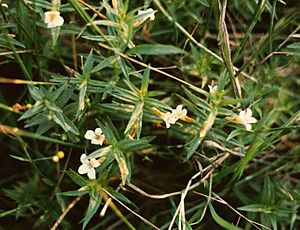Hedge hyssop facts for kids
Quick facts for kids Hedge hyssop |
|
|---|---|
 |
|
| Conservation status | |
| Scientific classification | |
| Genus: |
Gratiola
|
| Species: |
officinalis
|
The Hedge Hyssop (scientific name: Gratiola officinalis) is a fascinating plant. It's also known by many other names like gratiole, common hedgehyssop, grace of God, and herb of grace. This plant is a type of ornamental plant, which means people often grow it for its beauty.
It belongs to the plant family called Plantaginaceae. The Hedge Hyssop is a rhizomatous perennial herb. This means it has underground stems (rhizomes) that help it spread. It also lives for more than two years (perennial). This plant is originally from Europe.
Contents
What is Hedge Hyssop?
Hedge Hyssop is a small, green plant. It grows in wet places. You can often find it near rivers, ponds, or in damp meadows. It's known for its pretty flowers.
This plant is not very tall. It usually grows up to about 60 centimeters (2 feet) high. Its stems are upright and can be branched.
What Does it Look Like?
The leaves of the Hedge Hyssop are narrow and pointed. They grow in pairs along the stem. The leaves are bright green.
Its flowers are usually white or pale pink. They have a slightly yellowish throat. The flowers are shaped like small tubes. They grow from the leaf axils, which is where the leaves meet the stem. Hedge Hyssop flowers bloom in the summer. This is usually from June to August.
Where Does it Grow?
Hedge Hyssop is native to many parts of Europe. It can be found from Western Europe all the way to Central Asia. It prefers damp, marshy areas.
You might see it in wet grasslands or along the edges of streams. It likes soil that is rich in nutrients. It also needs plenty of sunlight to grow well.
How Does it Reproduce?
Hedge Hyssop reproduces in a couple of ways. It can spread using its rhizomes. These are underground stems. They grow horizontally and send up new shoots. This helps the plant form dense patches.
It also produces seeds. After the flowers are pollinated, they form small seed capsules. These capsules contain many tiny seeds. The seeds can then spread and grow new plants.
Uses Through History
Historically, Hedge Hyssop was used in traditional medicine. People believed it had various healing properties. It was used for different ailments.
However, it's important to know that this plant can be toxic. It contains compounds that can be harmful if ingested. Because of this, it is not used in modern medicine.
Important Note: Not for Self-Medication
Even though Hedge Hyssop was used in the past, you should never use it for self-medication. It is not safe. Always consult a doctor or healthcare professional for any health concerns.


